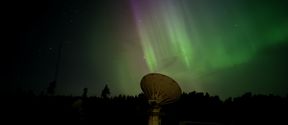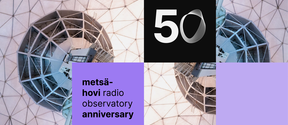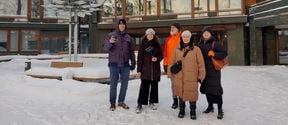Metsähovi Radio Observatory turns 50 and gets new telescopes
Students helped design and build the new telescopes, which expands the opportunities for multidisciplinary space research and education
Today is a celebration day at Aalto University Metsähovi Radio Observatory. Exactly 50 years ago, the the 14-metre radio telescope located in Kylmälä, Kirkkonummi, observed space for the first time. From within its protective dome, it gathers data from outer space 24 hours a day, 365 days a year.
The main radio telescope, when installed in the Metsähovi radio laboratory of Aalto University’s predecessor the Helsinki University of Technology, gave Finnish researchers access to large-scale radio science and radio astronomy research projects. Today, the observation activities of Metsähovi Radio Observatory include three main areas: research on active galaxies, radio monitoring of the Sun, and joint observations in collaboration with international radio telescope networks.
‘In the last ten years, we have moved increasingly into observatory activities, and Metsähovi is now one of the major research and teaching infrastructure at Aalto University, with its core activities also including radio astronomy and teaching on space-related radio technology’, says Joni Tammi, Director of Metsähovi Radio Observatory.
Metsähovi Compact Array, which is under construction, is an ensemble of several 5.5-meter radio telescopes. Two of telescopes have already made the first measurement results together. The construction of the third will start in the summer.
‘Ever since the 1990s, we’ve made joint observations with several telescopes around the world using our main instrument, the 14-metre radio telescope. The new system of smaller telescopes will function the same way – that is, the telescopes can be used either independently or together as a radio interferometer. Interferometry is a cutting-edge radio astronomy technology that combines individual radio telescopes into one giant telescope’, Tammi explains.
New telescopes expands the opportunities for multidisciplinary space research and education. Radio telescopes also create new opportunities to connect with schools. Metsähovi Radio Observatory will open its doors to comprehensive and upper secondary school groups during the spring, offering school groups unique hands-on experience in observations and astronomy.
Aalto University's Metsähovi Radio Observatory celebrates its 50th anniversary this year. Located in Kirkkonummi, Metsähovi is the only astronomical radio observatory in Finland. Research and technological development at Metsähovi focus on studying space with radio waves. Did you know that exactly half a century ago, on 11 April 1974, our radio telescope recorded its first radio-astronomical observations? Our collections of observational radio data have been expanding ever since. Read more at metsahovi.aalto.fi.

Students helped design and build the new telescopes, which expands the opportunities for multidisciplinary space research and education

Aalto University’s Metsähovi Radio Observatory has played an important role in the development of Finnish radio astronomy.

Aalto University's Metsähovi radio observatory turns 50 this year. On Observatory's birthday, Thursday 11. April, guests gathered together to celebrate the past decades and the development of radio astronomy in Finland.


